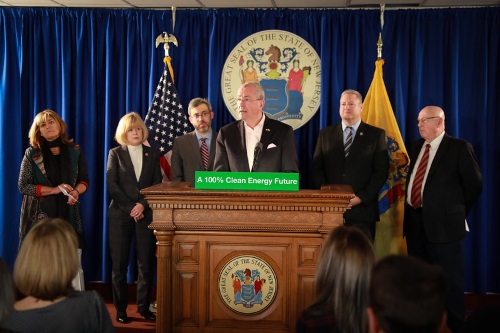New Jersey Governor Phil Murphy (D) has set forth an aggressive goal of achieving 100 percent clean energy by 2050 for the state – and the New Jersey Department of Transportation will play a key role in helping attain that goal.
The agency is part of a broad statewide transportation electrification effort in line with the Rejoining the Regional Greenhouse Gas Initiative or RGGI; a multi-state, market-based program that establishes a regional cap on carbon dioxide or CO2 emissions.
In mid-April, the governor announced that RGGI auction proceeds will provide $80 million each year to programs that reduce greenhouse gas emissions, with a new, more all-inclusive Energy Master Plan outlining several state investment strategies that aim to electrify New Jersey’s transportation sector.
Along with the Master Plan, the RGGI Strategic Funding Plan details how to move toward the goal of a greener transportation system. New Jersey’s plan for its RGGI revenue is designed to support legislation signed in January that calls for the state to have 330,000 registered electric vehicles or EVs by 2025 and 2 million by 2040. It also plans for 400 fast charging stations at 200 locations along major highways and communities by 2025.
To that end, the New Jersey DOT and several other state agencies – NJ TRANSIT, the New Jersey Board of Public Utilities, the Department of Environmental Protection, the Department of Community Affairs, the Department of Labor and Workforce Development, and the Economic Development Authority – will work together within their respective areas to achieve the RGGI’s strategic goals.
The specific strategies laid out for the New Jersey DOT within the plan include:
- Promoting the use of the Logo Sign Program and Tourist-Oriented Directional Signing or “LOGOS” program to display the locations of EV charging stations on blue state highway exit signs. The state will also work collaboratively with local governments on transportation planning and land use/housing planning that will enable multi-modal transportation and EV-ready infrastructure.
- Working to prioritize multi-modal accommodations in projects located in low- and moderate-income and environmental justice communities to promote more pedestrian and bicycle traffic as those two modes are part of the RGGI’s emission reduction strategies.
- Looking at re-evaluating “Level of Service” metrics that measure the quality of transportation services and traffic flow and develop plans to mitigate congestion and reduce idling time for vehicles.
- Working with local governments to promote implementation of “Complete Streets” policies in municipalities, possibly with additional grants and incentives. As part of these efforts, the New Jersey DOT and NJ TRANSIT will continue to lead a multi-agency “Smart Growth” program called the Transit Village Initiative, which helps municipalities redevelop or revitalize their downtowns into dense communities within a half-mile of transit centers.
- Deploying Transportation Systems Management & Operations or TSMO strategies to relieve road congestion through signal optimization technology; an effort funded via the federal Congestion Mitigation and Air Quality program to make traffic patterns more efficient and further reduce idling.
Yet even as New Jersey begins moving towards electrifying its transportation sector, the unintended consequences of funding shortages must also be considered.
The draft fiscal year 2020 New Jersey Transportation Capital Program, which funds both the New Jersey DOT and NJ TRANSIT for a total of $3.679 billion, depends on motor fuels tax revenues for funding – already significantly reduced due to the impact of the COVID-19 pandemic. As New Jersey encourages use of electric-powered vehicles, the state is also considering a replacement for lost fuel tax revenue and is participating in the I-95 Coalition Mileage Based User Fee study to see how such fees would affect different communities and how they would be collected.

